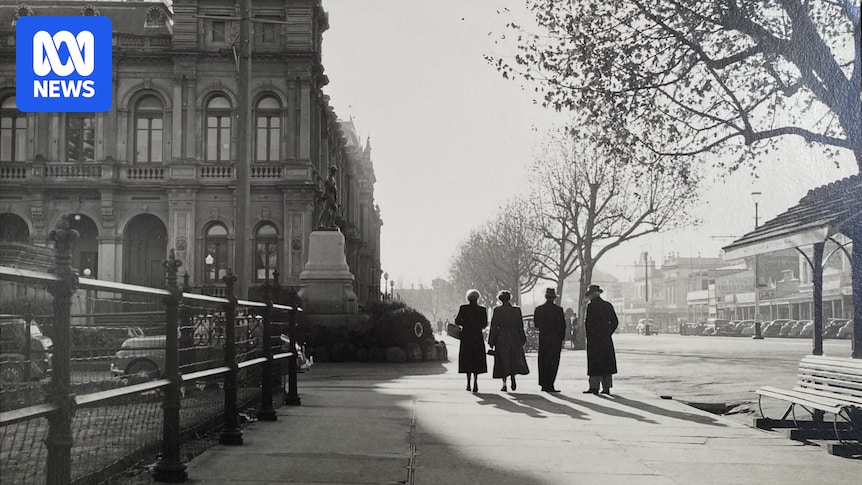A treasure trove of photographs taken by a tailor in the central Victorian city of Bendigo’s post-war period has been returned to the city.
The Allan Doney Photographic Collection comprising more than 14,000 negatives and 3,000 prints from the 1950s to ’70s, has been gifted from the National Trust of Australia to the Bendigo Historical Society.
Children on a carousel at the Bendigo Show circa 1954. (Supplied: Bendigo Historical Society)
Society president Euan McGillivray said the collection offered more than a “brilliant time capsule”.
“Bendigo when Allan was photographing was life after gold,” Mr McGillivray said.
“There’s so much to learn about how people lived, what they thought of themselves and how local and state governments thought about the developing city.”
Pall Mall in 1959 with Australia’s first Myer store, which opened in 1900. (Supplied: Bendigo Historical Society)
The city was in a period of transition from 100 years of continuous gold mining, with the closure of the last mine in 1954.
“Historically speaking there was a lot going on in Bendigo and Allan was here to capture it,” Mr McGillivray said.
Within the negatives are lost buildings and faces sure to be familiar to some in Bendigo.
Perhaps a relative was crossing Pall Mall or browsing the Bennetts Arcade when inspiration struck and Doney pressed the shutter button on his Rolleicord.
Allan Doney in a self-portrait. (Supplied: Bendigo Historical Society)
A tailor and photographer
Allan Doney was taking photos long before he arrived in Bendigo with his wife Constance in 1949.
“But he really excelled in Bendigo, I think he loved the city,” Mr McGillivray said.
People crossing Pall Mall at View Street in Bendigo, circa 1960. (Supplied: Bendigo Historical Society)
The Doneys set up a tailoring business in the Beehive Building on Pall Mall, the city’s main drag that routinely featured in his photography.
His amateur career was sparked when he was gifted a Kodak Box Brownie as a teenager.
RMIT photography historian Daniel Palmer said Doney clearly had a “very good eye”.
“[The photos] are a cut above just snapshots,” Professor Palmer said.
“They’re considered compositions that give them an additional aesthetic value, not so different from pictures collected by art museums.”
Children gather at the start of a soap box derby during the Bendigo Easter Fair, circa 1956. (Supplied: Bendigo Historical Society)
Professor Palmer said Doney was set apart from other amateurs or hobbyists by the subject of his photos, which at the time generally would have been family members or landscapes.
“It was less common for someone to be wandering the streets and taking photographs of strangers, and that’s of course what becomes more interesting over time,” Professor Palmer said.
Shoppers browse Bennetts Arcade in Bendigo, circa 1957. (Supplied: Bendigo Historical Society)
Doney’s photos did receive some recognition locally, landing on the front page of The Bendigo Advertiser with his coverage of Queen Elizabeth II’s visit in 1954.
“Bendigo is lucky to have this photographer who was capturing life so beautifully,” Professor Palmer said.
“I also hope they’re accessible more broadly.”
That work is underway now, with a six-month task ahead of the Bendigo Historical Society volunteers to catalogue, digitise and prepare for a likely exhibition in 2026.
Euan McGillivray with a sheet of negatives from the Allan Doney Photographic Collection. (ABC Central Victoria: Anna McGuinness)
Until last year the negatives were still in the paper bags and sleeves they were first stored in some 70 years ago.
It has taken the society’s volunteers well over 100 hours to painstakingly transfer the negatives from the brittle, scratchy bags into archival-grade storage materials.
National Trust of Australia (Victoria) collections manager Michelle Derrick said she was confident the collection would “enrich Bendigo’s cultural heritage” into the future.
“I look forward to seeing the collection shared more widely and celebrated throughout the local community,” she said.

